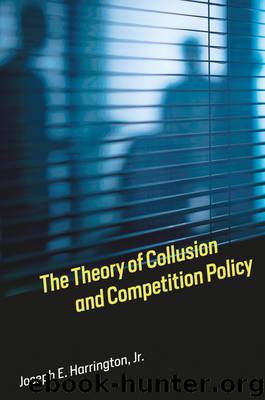The Theory of Collusion and Competition Policy by Harrington Joseph E. Jr.;

Author:Harrington, Joseph E., Jr.;
Language: eng
Format: epub
Tags: anti-trust; economics; econometrics; unlawful; theoretical; law; business; companies; firm behavior; market; anti-competition
Publisher: MIT Press
Thus, as the CA raises σ(q1) to make prosecution more likely for a small amount of collusion, it must increase to deter a low-cost cartel from engaging in a large amount of collusion. By setting σ(q) = 0 for quantities slightly below —and thereby not deterring low-cost cartels who collude a little—the CA can reduce , which saves on expected enforcement costs.
That argument ensures that the low-cost industry is deterred from engaging in a large amount of collusion, but it results in them engaging in a small amount of collusion. The reason that is acceptable to a welfare-maximizing CA is that if the low-cost cartel’s quantity is slightly below the competitive quantity , there is no first-order effect on welfare, but there is a first-order saving in enforcement costs associated with deterring more egregious collusion through the imitating of a high-cost competitive industry.2
Consider the case where the cost of a prosecution K is relatively low and the cost differential is not too large, so that the high-cost competitive supply exceeds the low-cost monopoly supply: (where is the monopoly quantity for an industry with cost ci). The optimal policy has σ(q) = 0 if and only if q ≥ 1, where . That is, for some quantity 1 less than the low-cost competitive supply but above the low-cost monopoly supply, the CA does not prosecute if quantity is at least 1. The low-cost industry optimally chooses to collude and produces the minimum quantity 1 that avoids prosecution. The high-cost industry chooses to compete and faces a positive probability of prosecution, . Hence, the optimal policy has only competitive industries being prosecuted! The CA’s policy is serving to constrain collusion when cost is low, rather than deterring those cartels from forming or prosecuting and convicting them. Of course, it could set σ(q) = 0 for all and thereby avoid prosecuting high-cost competitive industries, but then the low-cost cartel would restrict output more. It is worth noting that when enforcement cost K is close to zero, 1 is close to , so the low-cost cartel’s quantity is close to competitive levels. Thus, the high-cost cartel does not collude, the low-cost cartel colludes at a very low level, and expected enforcements costs are close to zero (because K is close to zero). The first-best outcome is approximated when enforcement costs are arbitrarily small.
Souam (2001) extends Besanko and Spulber (1989) by assuming a continuum of possible costs and allowing the penalty to depend not just on quantity but also the actual cost (which is only learned ex post). Furthermore, two classes of penalty regimes are considered: (1) revenue based so that F(q, c) = γP(q)q, and (2) profit based, so that F(q, c) = γ[P(q) − c]q. The analysis shows that which penalty regime is preferred depends on the model’s parameters.3 Like Besanko and Spulber (1989), Souam (2001) shows that it is best to accept some small reductions in output from collusion in exchange for avoiding large reductions.
The research reviewed thus far assumes that no error is made in the judicial process.
Download
This site does not store any files on its server. We only index and link to content provided by other sites. Please contact the content providers to delete copyright contents if any and email us, we'll remove relevant links or contents immediately.
The Secret History by Donna Tartt(16606)
The Social Justice Warrior Handbook by Lisa De Pasquale(11485)
Thirteen Reasons Why by Jay Asher(7780)
This Is How You Lose Her by Junot Diaz(5753)
Weapons of Math Destruction by Cathy O'Neil(5029)
Zero to One by Peter Thiel(4816)
The Myth of the Strong Leader by Archie Brown(4785)
Promise Me, Dad by Joe Biden(4440)
Stone's Rules by Roger Stone(4412)
Beartown by Fredrik Backman(4403)
How Democracies Die by Steven Levitsky & Daniel Ziblatt(4392)
The Fire Next Time by James Baldwin(4336)
100 Deadly Skills by Clint Emerson(4070)
A Higher Loyalty: Truth, Lies, and Leadership by James Comey(4024)
Rise and Kill First by Ronen Bergman(4008)
The David Icke Guide to the Global Conspiracy (and how to end it) by David Icke(3875)
The Farm by Tom Rob Smith(3869)
Secrecy World by Jake Bernstein(3773)
The Doomsday Machine by Daniel Ellsberg(3725)
